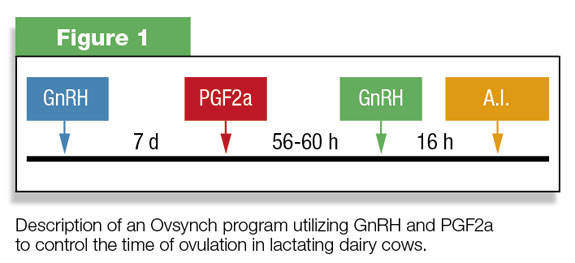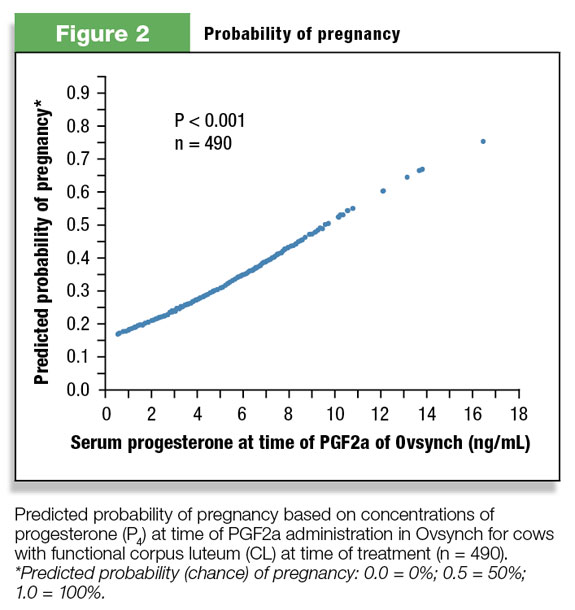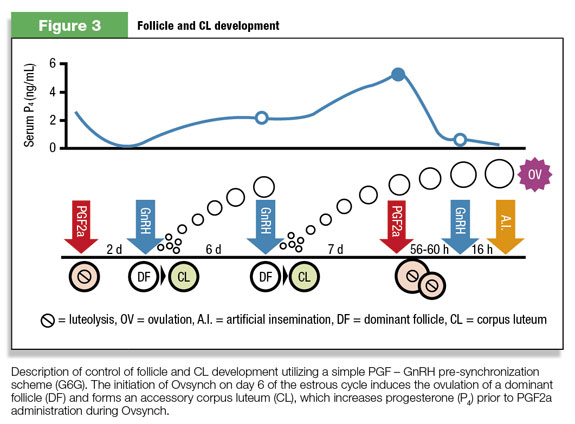The lactating dairy cow is not as fertile as she once was. And the likely culprit is not going to go away. But wait, there’s hope for ol’ Bessie. This story will outline the likely reasons for the decline of dairy cow fertility and discuss reproductive management methods to help alleviate this problem.
Infertility of the lactating dairy cow continues to be a critical problem limiting profitability and sustainability of dairy farms. Reproductive performance of lactating dairy cows is dependent upon service rate (or estrus detection rate), fertility of the service sire and maternal fertility.

Service rate can be controlled utilizing Ovsynch technology (Figure 1).
The majority of dairy producers in the U.S. regulate time to first and subsequent artificial inseminations (A.I.) with Ovsynch technology. High-fertility sires can be chosen utilizing the USDA-AIPL summaries sire conception rates.
Yet, maternal fertility, defined as the mother’s ability to ovulate a competent oocyte and provide an oviductal and uterine environment capable of fertilization and complete embryonic and fetal development, continues to be the key limiting factor for successful reproductive performance in lactating dairy cows.
Conception rates of lactating cows are approximately 30 percent compared to 60 percent for virgin dairy heifers when inseminated following a detected estrus. Increasing conception rates of lactating cows to that of heifers would allow producers to employ the most profitable calving interval strategies for cows with different milk production levels.
Aspects of maternal fertility that are limiting to conception and embryonic/fetal development are becoming better understood. Modifications to Ovsynch also are being developed to enhance maternal fertility while continuing to control service rate.
Why is fertility compromised in lactating dairy cows?
Circulating concentrations of steroid hormones significantly change following the transition from heifer to lactating cow.
Serum concentrations of progesterone and estrogen are reduced by about 50 percent in cows compared with heifers, even though the corpus luteum (CL; the structure in the ovary that produces progesterone) and ovulatory follicle (the structure in the ovary that produces estrogen and ovulates the egg) are larger in cows.
Duration of estrus also is longer in heifers. This is likely due to greater amounts of estrogen in circulation compared with cows. The difference in progesterone appears to influence follicular growth by prolonging the age of the ovulatory follicle.
Therefore, oocytes (eggs) from the ovulatory follicle of lactating dairy cows may have a lesser chance to be fertilized or develop into a competent embryo compared with oocytes of heifers which have greater concentrations of progesterone.
What is causing the differences in progesterone and estrogen concentrations between lactating dairy cows and heifers?
Wiltbank and co-workers at the University of Wisconsin – Madison found that feed dry matter intake differences of lactating dairy cows impacted circulating concentrations of progesterone and estrogen.
These hormones are primarily metabolized in the liver. When dry matter intake was increased, so was blood flow through the liver. Thus, the greater the blood flow through the liver, the greater the steroid hormone metabolism, resulting in less estrogen and progesterone remaining in circulation.
The research suggests that lactation per se is not the root of the problem. The reduced hormone concentrations likely are associated with the large amounts of feed that lactating cows must consume to produce large quantities of milk.

How can we resolve this problem?
Increasing circulating progesterone concentration during the growth of the ovulatory follicle is a key factor to increase fertility in lactating dairy cows.
Cows with greater progesterone concentrations at the time of prostaglandin F2α (PGF) administration during Ovsynch have greater probability of pregnancy (Figure 2).
Therefore, creating higher concentrations of progesterone during Ovsynch should compensate for the progesterone lost due to high metabolism by the liver of lactating dairy cows and enhance fertility.
Strategy to increase progesterone concentrations at time of PGF administration during Ovsynch
Multiple strategies previously have been tested to increase progesterone prior to PGF injection of Ovsynch.
In studies that used a controlled progesterone-releasing intravaginal device (or CIDR) to achieve greater concentrations of progesterone during Ovsynch, there was no significant increase in progesterone on the day of PGF injection of Ovsynch or in resulting conception rates of cycling cows. Concentrations of progesterone in cycling cows with a CIDR were similar to cows without a CIDR (2.7 compared with 2.8 ng/mL).
Thus, use of a CIDR may not be the best strategy to increase progesterone concentrations and enhance fertility in lactating dairy cows. We therefore examined the possibility that GnRH inducement of a second (accessory) CL during Ovsynch could be used to more effectively enhance progesterone concentrations.
In this case, cows would have two CL during Ovsynch, an older CL and a younger CL (accessory CL). The idea was that this accessory CL would increase the production of progesterone and compensate for that lost by liver metabolism.
Cows had the greatest chance to ovulate a follicle and create a new accessory CL when they were on day 6 or 7 of the estrous cycle when the first GnRH of Ovsynch was administered. More than 90 percent ovulated a first-wave dominant follicle and formed an accessory CL.
When the PGF of Ovsynch was administered 7 days later, cows that ovulated had both a primary 13-day-old or 14-day-old CL and a 7-day-old accessory CL. Cows with both CL (day 13 CL and day 7 CL) had correspondingly greater circulating concentrations of progesterone at time of the PGF of Ovsynch compared with cows that did not receive GnRH and only had a day 13 CL (5.22 vs.3.53 ng/mL, respectively).
Thus, presence of a young (day 7) accessory CL during Ovsynch positively impacted progesterone concentrations before artificial insemination.
What is the best way to ensure that cows are on day 6 of estrus cycle at time of first GnRH of Ovsynch?
To induce the accessory CL following the first GnRH of Ovsynch, cows must be pre-synchronized (prior to Ovsynch) to ensure they are in a stage of the estrous cycle that has both a high probability of ovulation of a dominant follicle to the first GnRH and control of subsequent CL regression with PGF.

In two previous studies (published and unpublished data), we observed rate of induction of accessory CL at day 4, 5, 6, 7 or 8 of the estrous cycle at the time of the first GnRH of Ovsynch.
The “day 6” interval (referred to as G6G; Figure 3) resulted in a greater percentage of cows ovulating to the first GnRH and inducing accessory CL compared with the other intervals.
If cows responded to both PGF and GnRH pre-synchrony treatments and were on day 6 of the cycle at time of first GnRH of Ovsynch, 97 percent of cows contained accessory CL, had greater progesterone concentrations and a greater probability of a pregnancy.
What current programs seem to be working best to achieve greater conception rates?
There are several programs that enhance fertility of dairy cows that utilize the technologies described above to enhance progesterone. We recommend three programs for first-service: Double Ovsynch, G6G and Presynch-11.
The recommended resynchronization programs (setting cows up for A.I. following a pregnancy diagnosis) are: G6G, GGPG (for cows without a CL at diagnosis), and an abbreviated Presynch-11.
Summary
This article provided a basis for the concept that low progesterone in lactating dairy cows due to enhanced steroid metabolism may be the underlying cause of the low fertility that has plagued dairy herds for the past two decades. We have developed synchronization strategies that partially solve this problem.
Enhancing the percentage of cows that respond to the first GnRH of Ovsynch allows for more cows with accessory CL, greater concentrations of progesterone at time of induced luteolysis (PGF of Ovsynch), and a greater chance for pregnancy. PD
References omitted due to space but are available upon request to editor@progressivedairy.com.
—Excerpts from Michigan Dairy Review – Vol. 16, No. 2, April 2011
Richard Pursley is an assoicate professor of reproductive management with Michigan State University. Email Richard Pursley.






